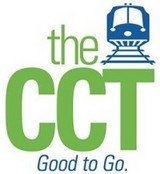The Corridor Cities Transitway and the future of the middle suburbs
According to the Gazette, Maryland state planners are optimistic that private sector funding might help pay for the Corridor Cities Transitway. The Transitway is a proposed line north of Shady Grove along the 270 corridor, through some areas planned for high density commercial and residential development. A train line here would encourage human scale, energy efficient, walkable urban growth—if Montgomery County actually builds the line before the development. That’s not always what’s happened in the past; Montgomery County has a history of approving development, calling it “transit-oriented,” and then forgetting about the transit.
In the 1980s and 1990s, county officials approved development at the intersection of Briggs-Chaney Road and US-29, and also most of Olney, based on the hint of potentially, maybe, sort of, possibly, hopefully, you know, one day running a BRT line up Georgia Ave and US-29. They never did, and the “transit-oriented” development has no transit, nor is it so oriented. History could repeat itself with the Corridor Cities Transitway.
However, there are reasons to be optimistic this time around. When the county approved the Briggs-Chaney and Olney developments, Transit-Oriented Development was a new buzzword that was novel to the planners of the time. Both of those previous failures were doomed from the start, as both developments have car-dependent forms. Even if good transit someday connected to those places, they would still need a North Arlington style suburban-to-urban retrofit in order to function as true transit-oriented walkable urban places.
However, the Corridor Cities Transitway area map (PDF) shows promise. There are notable major employers such as the National Institute of Standards and Technology (NIST), the Johns Hopkins University Gaithersburg satellite campus, and the U.S. Department of Energy, shopping destinations such as the Rio (a faux “town center”-format mall at the intersection of I-370 and I-270), and existing population centers and local retail centers like Germantown and the Kentlands section of Gaithersburg. While “downtown” Germantown would need a little retrofitting with a walkable grid, Kentlands is a New Urbanist development that is transit-ready.
Frustratingly, some officials are already pushing for Bus Rapid Transit over light rail for the Corridor Cities Transitway. I’ve written previously about BRT’s shortcomings. The arguments for light rail on the Corridor Cities Transitway are similar to those on the Purple Line, and similar reasons: capacity, travel times, long term costs, and ability to induce TOD.
This project is a very different project than the Purple Line. The Purple Line will connect existing major job and population centers in the inner suburbs. It will also greatly increase regional mobility by filling in some gaping holes in our Metro system. In this respect, it is similar to the Silver Line through Tysons Corner, while the Corridor Cities Transitway is more akin to the Silver Line west of Tysons Corner: connect some sparse dots in Favored Quarter suburbia and focus future growth on transit-oriented walkable urban hubs.
Regardless of whether one likes or dislikes the form of car-dependent suburbia, it exists, and many millions of Americans currently live there. Our battle for energy independence and against climate change will partially hinge on whether we can retrofit our middle suburbs in a more transit-oriented manner. For this to happen, we have to build more transit. The Corridor Cities Transitway, built with light rail, will be a good step in the right direction.

